Small overlap front: driver-side
Rating applies to 2007-17 models
Tested vehicle: 2013 Jeep Wrangler Sport 2-door 4wd
The Jeep Wrangler was redesigned for the 2007 model year. For the 2018 model year only, the Wrangler was renamed the Wrangler JK, because the JK was built concurrently through much of the same model year as the redesigned 2018 Wrangler. These ratings apply only to the 2007-17 Wrangler and 2018 Wrangler JK.
| Evaluation criteria | Rating |
|---|---|
| Structure and safety cage | |
| Driver injury measures | |
| Head/neck | |
| Chest | |
| Hip/thigh | |
| Lower leg/foot | |
|
Driver restraints and dummy kinematics
The dummy’s movement was well controlled. The dummy’s head loaded the frontal airbag, which stayed in front of the dummy until rebound. However, the Wrangler is one of a handful of passenger vehicles still sold without standard side airbags to protect the head and chest from contact with side structure and outside objects. | |
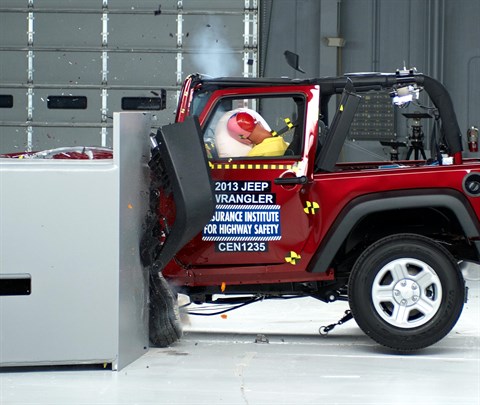
Action shot taken during the small overlap frontal crash test.

The dummy's position in relation to the door frame, steering wheel, and instrument panel after the crash test indicates that the driver's survival space was maintained reasonably well.
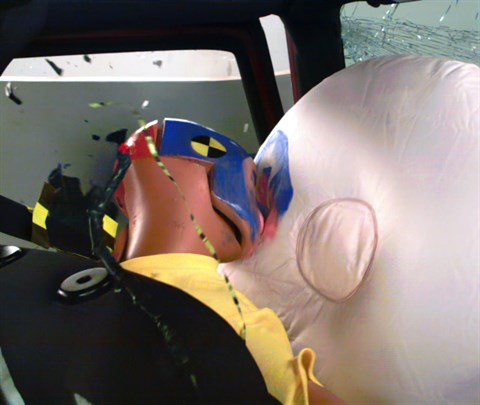
The dummy’s movement was well controlled. The dummy’s head loaded the frontal airbag, which stayed in front of the dummy until rebound. However, the vehicle lacks standard side airbags to protect the head and chest from contact with side structure and outside objects.
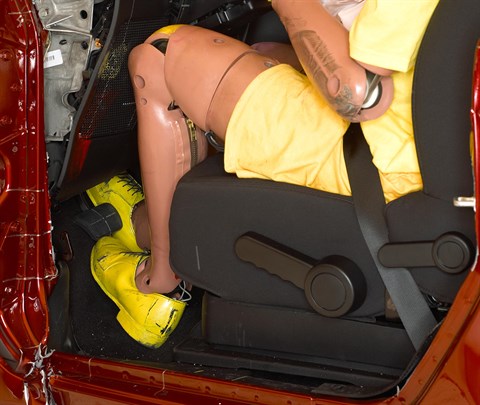
Intrusion of the instrument panel and footwell was sufficient to contribute to a high risk of injuries to the left knee, both thighs, and the left lower leg and a moderate risk of injury to the left foot.
Moderate overlap front: original test
Rating applies to 2007-17 models
Tested vehicle: 2007 Jeep Wrangler X 2-door 4wd
The Jeep Wrangler was redesigned for the 2007 model year. A larger, heavier 4-door model was added for the first time, but the front ends of the 4-door and 2-door are very similar. For the 2018 model year only, the Wrangler was renamed the Wrangler JK, because the JK was built concurrently through much of the same model year as the redesigned 2018 Wrangler.
The Institute tested the 4-door Wrangler first, which received a Good overall frontal crash test rating. Therefore, frontal ratings for the 2-door are assigned by the Institute based on a test conducted by Chrysler. These ratings apply only to the 2007-17 Wrangler and 2018 Wrangler JK.
| Evaluation criteria | Rating |
|---|---|
| Overall evaluation | |
| Structure and safety cage | |
| Driver injury measures | |
| Head/neck | |
| Chest | |
| Leg/foot, left | |
| Leg/foot, right | |
| Driver restraints and dummy kinematics | |
Side: original test
Rating applies to 2007-17 models
Tested vehicle: 2008 Jeep Wrangler Sahara 2-door 4wd without optional side airbags
The Jeep Wrangler was redesigned for the 2007 model year. For the 2018 model year only, the Wrangler was renamed the Wrangler JK, because the JK was built concurrently through much of the same model year as the redesigned 2018 Wrangler. These ratings apply only to the 2007-17 Wrangler and 2018 Wrangler JK.
During the crash, the driver door opened. This opening didn't significantly affect dummy movement during the test but shouldn't happen because, in some crashes, it could allow partial or complete occupant ejection, especially if the occupant is unbelted. This door opening resulted in a structure rating downgrade from good to acceptable.
| Evaluation criteria | Rating |
|---|---|
| Overall evaluation | |
| Structure and safety cage | |
| Driver injury measures | |
| Head/neck | |
| Torso | |
| Pelvis/leg | |
|
Driver head protection
Although the intruding barrier did not hit the dummy's head in this test, the head was not protected from contacts outside the vehicle. This indicates that only slightly different crash circumstances could produce a direct hit to a person's head. | |
| Rear passenger injury measures | |
| Head/neck | |
| Torso | |
| Pelvis/leg | |
|
Rear passenger head protection
The dummy's head was hit by the diagonal steel tube supporting the convertible top. This impact did not produce high head injury measures, but the head protection is inadequate. | |
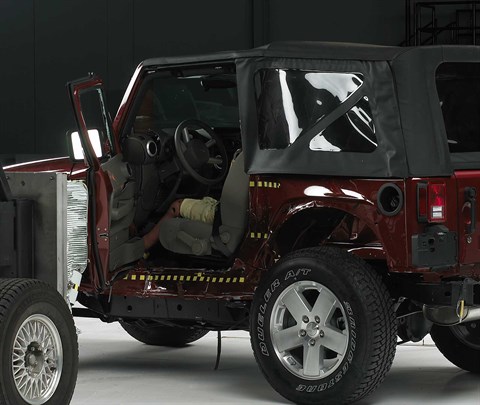
View of the vehicle and barrier just after the crash test, showing the open driver door.

View of the vehicle after the crash with door removed, showing damage to the occupant compartment.
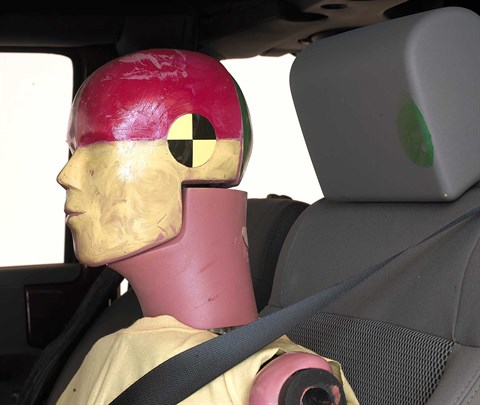
Although the dummy's head was not hit by the barrier, shattering glass from the side window left deep gouges on the top of the head.
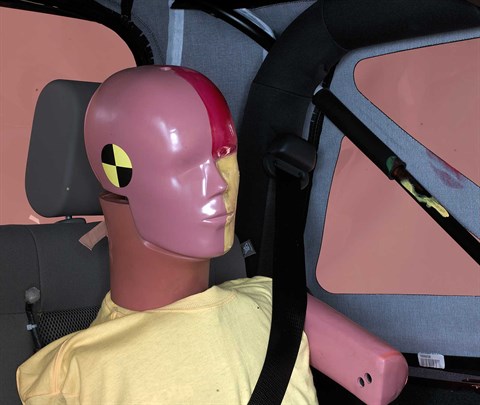
Smeared greasepaint shows where the rear passenger dummy's head was hit by the diagonal steel tube supporting the convertible top.
Head restraints & seats
Seat type: Manual cloth seats
| Overall evaluation | |
|---|---|
| Dynamic rating | |
| Seat/head restraint geometry |
About the head restraint & seat test
Currently, IIHS tests apply only to front seats.
Headlights
Trim level(s)
- All trims
| Evaluation criteria | Rating |
|---|---|
| Low-beam headlight type | Halogen reflector |
| High-beam headlight type | Halogen reflector |
| Curve-adaptive? | No |
| High-beam assist? | No |
|
Overall rating | |
| Distance at which headlights provide at least 5 lux illumination: | |
Low beams
On the straightaway, visibility was fair on the left side of the road and inadequate on the right side. On curves, visibility was inadequate in all 4 tests.
The low beams created some glare.
High beams
On the straightaway, visibility was inadequate on both sides of the road. On curves, visibility was inadequate in all 4 tests.
Child seat anchors
Rating applies to 2016-17 models
| Evaluation criteria | Rating |
|---|---|
| Overall evaluation | |
| Vehicle trim | Sport |
| Seat type | cloth |
This vehicle has 2 rear seating positions with complete child seat attachment (LATCH) hardware.
| Evaluation criteria | Rating |
|---|---|
| Overall evaluation | |
| Vehicle trim | Sport |
| Seat type | cloth |
| Rating icon | Rating |
|---|---|
| G | Good |
| A | Acceptable |
| M | Marginal |
| P | Poor |
| Seating positions that rely on borrowed lower anchors or have only a tether anchor available are not rated. | |
thether anchor symbol | Tether anchor |
lower anchor symbol | Lower anchors |
| Lower anchor(s) can be borrowed from adjacent positions(s) | |
| No hardware available |
Details by seating position
| Position | Rating |
|---|---|
| 1 | |
| Tether anchor | |
| hard-to-find location | |
| other hardware could be confused for anchor | |
| Lower anchors | |
| too deep in seat | |
| not too much force needed to attach | |
| easy to maneuver around anchors | |
| 3 | |
| Tether anchor | |
| hard-to-find location | |
| other hardware could be confused for anchor | |
| Lower anchors | |
| too deep in seat | |
| not too much force needed to attach | |
| easy to maneuver around anchors |
